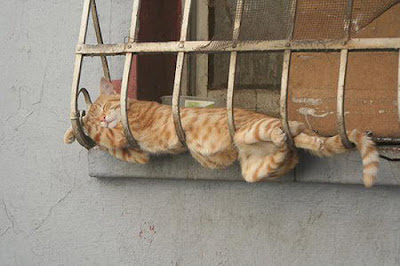This has got to be one of the coolest looking animals we've seen in awhile! A new species of purple crab was found recently in the Philippines, near the island of Palawan. The purple crab is a freshwater animal and is endemic to Palawan, meaning it is found only in that location.
Unfortunately, this species is endangered. There are several mining projects taking place on Palawan that could threaten to damage or destroy the crabs' habitats. The purple crab has a higher chance of extinction because it is endemic to the island and has only adapted to its unique environment.
Monday, April 30, 2012
Friday, April 27, 2012
Wednesday, April 25, 2012
The Giant Manta Ray - Enigma Of The Sea
The giant manta ray is a bit of an enigma in the ocean world. Though they are the third-largest sea creature, with only whales and sharks being larger, not much is known about them. Their large size (up to 25 feet across and 5,300 pounds!) makes it extremely difficult to keep one in captivity for observation. Currently there are just four giant manta rays in captivity.
The term manta is Spanish for blanket and it aptly describes the look of the rays’ large “wings” as they swim. They are extremely strong swimmers, and it’s possible they are able to swim across the open ocean.
Manta rays live in tropic and sub-tropic waters. They frequently visit “cleaning stations” where small fish swim over their skin, feeding on dead tissue and parasites. Manta rays themselves are bottom feeders, eating things like plankton and fish larvae.
Images via here and here.
The term manta is Spanish for blanket and it aptly describes the look of the rays’ large “wings” as they swim. They are extremely strong swimmers, and it’s possible they are able to swim across the open ocean.
Manta rays live in tropic and sub-tropic waters. They frequently visit “cleaning stations” where small fish swim over their skin, feeding on dead tissue and parasites. Manta rays themselves are bottom feeders, eating things like plankton and fish larvae.
Images via here and here.
Monday, April 23, 2012
Not All Bugs Are Nasty
When most people think of bugs and insects, it's usually not very pleasant. They think of creepy, crawly and all-around-icky things that deserve to be squashed. But not all bugs are created equal, and not all bugs are ugly.
A photo roundup from PetsLady.com showed us that some bugs are just as cute, if not cuter, than puppies and kittens! Sound hard to believe? Take a look for yourself...
To see the full list of cute bugs, click here. And PS, TheJungleStore.com is home to some pretty cute bugs and insects too...
A photo roundup from PetsLady.com showed us that some bugs are just as cute, if not cuter, than puppies and kittens! Sound hard to believe? Take a look for yourself...
The Big-Eyed Caterpillar
These eyes are used to deter predators. When the caterpillar feels threatened, it can contract its head segments, which makes the eyes appear bigger and the caterpillar look more dangerous.
The Pink Lady Katydid
This bug gets it bright hue from a genetic condition that makes them bright pink instead of the normal green. They're very pretty and very rare to spot.
The Human-Face Beetle
The face-like designs on this bug's back help it evade predators. While they ponder whether it's a meal or an enemy, the beetle has time to get away.
To see the full list of cute bugs, click here. And PS, TheJungleStore.com is home to some pretty cute bugs and insects too...
Friday, April 20, 2012
Help Protect The Animals This Earth Day
At TheJungleStore.com, we love animals of all kinds, from stuffed and plush to real and wild. That's why, this Earth Day, we're asking you to consider supporting a charity that helps protect our animals and their natural habitats. If you're not sure which organization to contribute to, we've listed some ideas for you below!
The Nature Conservancy works to protect the lands and waters that animals (and people) depend on. It's a global organization that has started initiatives and conservation programs to help protect the rain forests, coral reefs, migratory birds and many more! Visit them at Nature.org.
The National Wildlife Federation is America's largest conservation organization, working to protect our nations wildlife and their dwindling habitats. Its website also has a great feature where you can choose a specific cause you want to donate to, including polar bears, endangered seals and creating wildlife corridors. See more at NWF.org.
The Rainforest Action Network organizes environmental campaigns to educate major corporations on ways their practices can be sustainable and more environmentally-friendly while still being profitable. They also aim to educate the public about corporate impact on the environment. Learn about their mission at RAN.org.
The National Audubon Society's mission is "To conserve and restore natural ecosystems, focusing on birds, other wildlife, and their habitats for the benefit of humanity and the earth's biological diversity." The society works through grassroots conservation efforts, educational programs and outreach that helps educate lawmakers, agencies and the public. See them at Audubon.org.
The National Park Foundation works in partnership with the National Park Services to support the nearly 400 national parks in America, such as Yellowstone, Yosemite, Big Bend and Joshua Tree. The foundation has three areas of focus: conservations and preservation; education; and community engagement. Visit them at NationalParks.org.
The Sierra Club is one of the oldest, and largest, grassroots conservation programs in the country. It works to protect animal habitats and America's waters by focusing on such initiatives as natural gas reform, decreasing dependence on fossil fuels and creating habitats that are resilient against climate change. Learn more at SierraClub.org.
One of the biggest conservation organizations, the WWF has initiatives and programs that span the spectrum. Their currents goals include protecting and restoring species and their habitats, working locally to strengthen communities ability to conserve their natural resources and mobilizing volunteers to support conservation. Visit their website at WorldWildlife.org.
The National Wildlife Federation is America's largest conservation organization, working to protect our nations wildlife and their dwindling habitats. Its website also has a great feature where you can choose a specific cause you want to donate to, including polar bears, endangered seals and creating wildlife corridors. See more at NWF.org.
The Rainforest Action Network organizes environmental campaigns to educate major corporations on ways their practices can be sustainable and more environmentally-friendly while still being profitable. They also aim to educate the public about corporate impact on the environment. Learn about their mission at RAN.org.
The National Audubon Society's mission is "To conserve and restore natural ecosystems, focusing on birds, other wildlife, and their habitats for the benefit of humanity and the earth's biological diversity." The society works through grassroots conservation efforts, educational programs and outreach that helps educate lawmakers, agencies and the public. See them at Audubon.org.
The National Park Foundation works in partnership with the National Park Services to support the nearly 400 national parks in America, such as Yellowstone, Yosemite, Big Bend and Joshua Tree. The foundation has three areas of focus: conservations and preservation; education; and community engagement. Visit them at NationalParks.org.
The Sierra Club is one of the oldest, and largest, grassroots conservation programs in the country. It works to protect animal habitats and America's waters by focusing on such initiatives as natural gas reform, decreasing dependence on fossil fuels and creating habitats that are resilient against climate change. Learn more at SierraClub.org.
One of the biggest conservation organizations, the WWF has initiatives and programs that span the spectrum. Their currents goals include protecting and restoring species and their habitats, working locally to strengthen communities ability to conserve their natural resources and mobilizing volunteers to support conservation. Visit their website at WorldWildlife.org.
Thursday, April 19, 2012
Stephen Joseph Ladybug Rain Coat Celebrity Sighting
We love it when we see a celebrity enjoying one of our brands! Take a look at this picture of movie star Jessica Alba and her little girl, Honor. While visiting drizzly Japan, Honor is sporting the Stephen Joseph Ladybug Rain Coat - doesn't she look cute?
Visit TheJungleStore.com to see all of our Stephen Joseph products!
Wednesday, April 18, 2012
Cats Imitating Art
When you think about cats, there are several things that instantly pop into your mind. Furry. Purring. Meowing when they want food or attention. Coming up for pets and then biting your hand when they’ve had enough. But you’ve probably never thought about their artistic sides.
What’s that, you didn’t realize cats were artistic? Neither did we, until we saw this article from BuzzFeed.com that showed us some excellent examples of cats imitating famous paintings. Take a look at some of our favorites…
To see the rest of this gallery, click here. And let us know if your cat imitates any famous pieces of artwork – we want to see it!
What’s that, you didn’t realize cats were artistic? Neither did we, until we saw this article from BuzzFeed.com that showed us some excellent examples of cats imitating famous paintings. Take a look at some of our favorites…
"Romeo And Juliet" by Ford Madox Brown (1870)
"Apple, Peaches, Pears, And Grapes" by Paul Cezanne (1879)
"Women In Blue Dress" by Richard Edward Miller (1909)
"Grande Odalisque" by Ingres (1814)
"Self Portrait Yawning" by Joseph Ducreux (1780)
To see the rest of this gallery, click here. And let us know if your cat imitates any famous pieces of artwork – we want to see it!
Monday, April 16, 2012
Japanese Giant Salamander
This is one salamander we wouldn't want as a pet. The Japanese Giant Salamander is the second largest salamander in the world, growing up to five feet in length and weighing 80 pounds! And when bred in captivity, it can live a very long time - one giant salamander at the Amsterdam Zoo lived to be 52!
The giant salamander is a nocturnal animal, and completely aquatic. It has extremely poor eyesight and uses special sensory cells, which cover its entire body, to detect vibrations in its environment. It relies on these cells when hunting for insects, frogs, freshwater crabs and fish. The giant salamander is slow moving, but that's OK since it doesn't have many natural predators. When it does need to fight off an attack, it uses its long tail and powerful teeth.
The Japanese Giant Salamander is considered a bit of a relic of an animal. It's appearance has hardly changed in 20 million years, and ancient Japanese folklore tells tales of the giant salamander. Festivals and parades are held its honor each year.
Learn more about the Japanese Giant Salamander by watching this video from National Geographic!
The giant salamander is a nocturnal animal, and completely aquatic. It has extremely poor eyesight and uses special sensory cells, which cover its entire body, to detect vibrations in its environment. It relies on these cells when hunting for insects, frogs, freshwater crabs and fish. The giant salamander is slow moving, but that's OK since it doesn't have many natural predators. When it does need to fight off an attack, it uses its long tail and powerful teeth.
The Japanese Giant Salamander is considered a bit of a relic of an animal. It's appearance has hardly changed in 20 million years, and ancient Japanese folklore tells tales of the giant salamander. Festivals and parades are held its honor each year.
Learn more about the Japanese Giant Salamander by watching this video from National Geographic!
Friday, April 13, 2012
Black Cats - Unlucky Or Misjudged?
Today is Friday the 13th, which is the day when you're supposed to carry your lucky rabbits foot, be careful around mirrors, avoid walking underneath any ladders and make sure not to let any black cats cross your path.
Why did black cats get such a bad rap? Why not tabby cats or calico cats? Why is it the poor black cats that get all the negative attention?
According to Wikipedia, it's actually just certain Western cultures that have painted the black cat as a symbol of bad luck. They're a symbol of good luck in Great Britain, Ireland, and Japan and the Scottish think it's a sign of prosperity if a black cat shows up at your home.
There are other examples of how black cats have historically been associated with good luck. Sailors, if they were thinking about bring a "ship cat" on board, would want a black one. Some sailors wives even kept black cats at home. And in ancient Egypt, where they worshiped the cat goddess Bastet, it was believe that hosting a black cat in your home would help you gain favor with the goddess.
So the next time you see a black cat cross your path, don't be scared! These raven-haired felines aren't unlucky at all... if anything, they're just a little unloved.
Why did black cats get such a bad rap? Why not tabby cats or calico cats? Why is it the poor black cats that get all the negative attention?
According to Wikipedia, it's actually just certain Western cultures that have painted the black cat as a symbol of bad luck. They're a symbol of good luck in Great Britain, Ireland, and Japan and the Scottish think it's a sign of prosperity if a black cat shows up at your home.
There are other examples of how black cats have historically been associated with good luck. Sailors, if they were thinking about bring a "ship cat" on board, would want a black one. Some sailors wives even kept black cats at home. And in ancient Egypt, where they worshiped the cat goddess Bastet, it was believe that hosting a black cat in your home would help you gain favor with the goddess.
So the next time you see a black cat cross your path, don't be scared! These raven-haired felines aren't unlucky at all... if anything, they're just a little unloved.
 | |||||
| Come on, does this guy really look scary to you? |
Thursday, April 12, 2012
Cats Sleeping In Weird Positions
Cats spend 2/3 of their life sleeping, which equals to 16 to 20 hours each day! That’s more sleep than any other mammal except for opossums and certain types of bats.
Why does your cat sleep so much? Because it’s a predator with few natural enemies, so it can afford to take longer snoozes. And, being a predator, cats need sleep for the bursts of energy they exert while stalking, pouncing and wrestling with their prey.
Cats are able to sleep sitting up. Their muscles stiffen to keep them upright – in this position they are ready to spring into action at the first sign of prey (or trouble). Their sense also record scents and sounds during up to 70 percent of sleep, so they can wake up the instant they smell the scent of a mouse or hear the whistle of a bird.
See the original post and more pics of cats sleeping in weird positions and places at BuzzFeed.com.
Monday, April 9, 2012
River Monsters
In the case of Jeremy Wade, however, his Big Fish stories are true. And there’s proof. New episodes of his series, River Monsters, started last night on Animal Planet. Wade has caught everything from Vampire Piranhas to a Goliath grouper (as in 350 pounds) to bull sharks, truly monstrous creatures that will make you think twice about going out into the water.
 |
| Jason Wade and a monster tigerfish. (Photo via.) |
Watch River Monsters on Sundays at 10 p.m. EST, or check out clips on the Animal Planet website. And check out a few of our favorite River Monsters, recently captured in The Jungle Store warehouse ;-)
Find these and other aquatic creatures at TheJungleStore.com!
The Fennec What?
Let’s play a guessing game. What type of animal do you think this cute little guy is? A large-eared Chihuahua? A mini hyena? Maybe some kind of exotic cat?
The correct answer is: fox. Fennec fox to be specific. Characterized by their noticeably large and pointed ears, fennec foxes are most commonly found in the Central Sahara desert. They are nocturnal animals, hunting for rodents, insects, birds and bird eggs. They also eat a lot of vegetation, a good source of water for them in the desert.
Fennec foxes are one of the few wild animals that can be easily domesticated, partly due to their their small size (smaller than most housecats) and their friendly nature. However, they have a very high energy level and some habits, like storing food in case of feminine and trying to burrow into furniture, which can cause problems.
Want a cute little fennec fox of your own, but afraid your household couldn’t handle that kind of pet? The Jungle Store has this sweet little stuffed fennec fox from Wild Republic! He won't tear apart your couch cushions, and he's just $13.99!
The correct answer is: fox. Fennec fox to be specific. Characterized by their noticeably large and pointed ears, fennec foxes are most commonly found in the Central Sahara desert. They are nocturnal animals, hunting for rodents, insects, birds and bird eggs. They also eat a lot of vegetation, a good source of water for them in the desert.
Fennec foxes are one of the few wild animals that can be easily domesticated, partly due to their their small size (smaller than most housecats) and their friendly nature. However, they have a very high energy level and some habits, like storing food in case of feminine and trying to burrow into furniture, which can cause problems.
Want a cute little fennec fox of your own, but afraid your household couldn’t handle that kind of pet? The Jungle Store has this sweet little stuffed fennec fox from Wild Republic! He won't tear apart your couch cushions, and he's just $13.99!
Friday, April 6, 2012
Bees: The Self-Medicating Insect
It turns out that bees are more resourceful than we realized. According to an article from LiveScience.com, a new study found that bees are able to self medicate when they get sick.
Specifically, the article says, when bees are infected with fungi, they go out and collect extra amounts of anti-fungal plant extracts and coat their hives with them, in addition to the plant resins and wax that already line their hives (which also have anti-fungal properties).
The study also found that bees will remove larvae that are infected with the fungi from the hives. The bees can also tell which fungi are life-threatening and which aren't. All of this could help bee keepers maintain healthier bee colonies, since typically they prefer to keep hives that have less resin since it's not as sticky.
Shop TheJungleStore.com for a wide variety of stuffed and plush bees, bee party decorations, toys and more!
 |
| Photo via. |
The study also found that bees will remove larvae that are infected with the fungi from the hives. The bees can also tell which fungi are life-threatening and which aren't. All of this could help bee keepers maintain healthier bee colonies, since typically they prefer to keep hives that have less resin since it's not as sticky.
Shop TheJungleStore.com for a wide variety of stuffed and plush bees, bee party decorations, toys and more!
Wednesday, April 4, 2012
The European Adder
The European adder has the widest range of any terrestrial snake species - it can be found throughout most of Western Europe to Far East Asia to north of the Arctic Circle! It can also live at higher altitudes than any other snake (2600 meters above sea level).
European Adders are the only venomous snake to inhabit Britain, but they are entirely absent from Ireland and the Channel Islands. The adder is a oviparous species, which means it gives birth to live young. Like bears, adders in the wild will hibernate for 5 to 7 months, emerging when the weather gets warmer and they can bask in the sun.
The diet of the adder mainly consists of small rodents, but they will also occasionally prey on nesting birds, lizards and frogs. One way the adder hunts is by attacking their prey and injecting them with venom, then immediately releasing them to avoid a counterattack. The prey then wonders off to die, and the adder uses its sense of smell to follow the animal's scent trail and eat the dead prey.
See The Jungle Store's great selection of stuffed and plush snakes, snake gifts and more here!
European Adders are the only venomous snake to inhabit Britain, but they are entirely absent from Ireland and the Channel Islands. The adder is a oviparous species, which means it gives birth to live young. Like bears, adders in the wild will hibernate for 5 to 7 months, emerging when the weather gets warmer and they can bask in the sun.
The diet of the adder mainly consists of small rodents, but they will also occasionally prey on nesting birds, lizards and frogs. One way the adder hunts is by attacking their prey and injecting them with venom, then immediately releasing them to avoid a counterattack. The prey then wonders off to die, and the adder uses its sense of smell to follow the animal's scent trail and eat the dead prey.
See The Jungle Store's great selection of stuffed and plush snakes, snake gifts and more here!
Monday, April 2, 2012
Happy National Ferret Day!
That's right, today is National Ferret Day! We honestly didn't know these little guys had a day dedicated all to themselves, but we are happy to celebrate them!
For those of you that have ferrets as pets, did you know that ferrets have been domesticated animals for 2,500 years? The majority of ferrets are kept as pets nowadays, although there are still some parts of the world where ferrets are used to hunt pesky rabbits.
A few other facts about ferrets: They are crepuscular animals, which means they sleep 14-18 hours each day (lucky them). They are most active around dusk and dawn, and when feeling excited or playful they do a move nicknamed the "weasel war dance." Ferrets are social animals, living in groups which are called a "business."
Want to learn more about ferrets? Then take a look at our Ferret Animal Facts page. And if you're a fellow ferret fan, check out the cute stuffed ferrets available at TheJungleStore.com!
For those of you that have ferrets as pets, did you know that ferrets have been domesticated animals for 2,500 years? The majority of ferrets are kept as pets nowadays, although there are still some parts of the world where ferrets are used to hunt pesky rabbits.
 |
| Happy National Ferret Day! |
A few other facts about ferrets: They are crepuscular animals, which means they sleep 14-18 hours each day (lucky them). They are most active around dusk and dawn, and when feeling excited or playful they do a move nicknamed the "weasel war dance." Ferrets are social animals, living in groups which are called a "business."
Want to learn more about ferrets? Then take a look at our Ferret Animal Facts page. And if you're a fellow ferret fan, check out the cute stuffed ferrets available at TheJungleStore.com!
 |
| Ferret handpuppet from Folkmanis |
Subscribe to:
Comments (Atom)






































